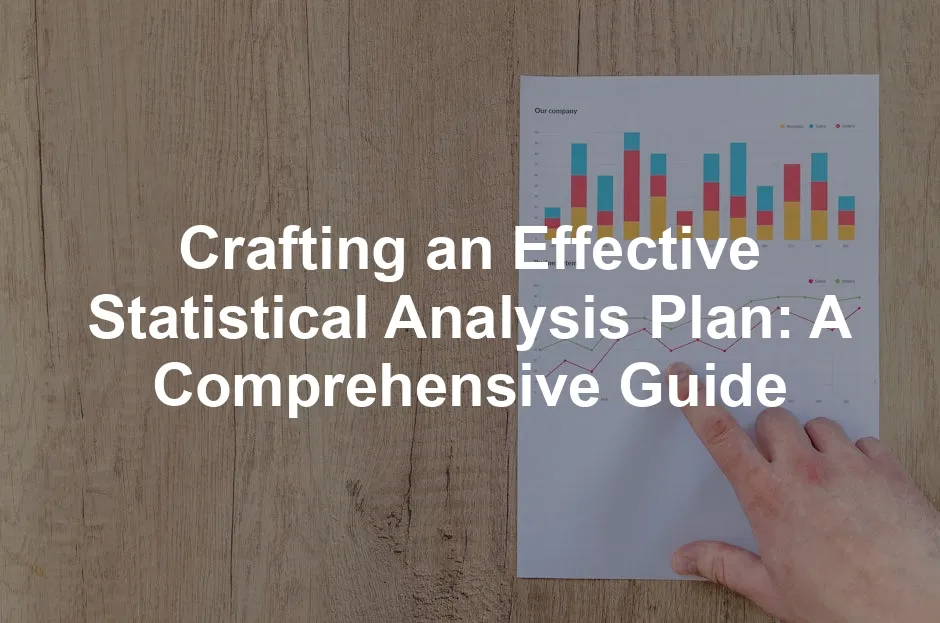Introduction
A Statistical Analysis Plan (SAP) is a critical document in research, particularly in clinical trials. Think of it as the GPS for navigating through the labyrinth of data analysis. Without it, researchers risk getting lost in the maze of numbers, assumptions, and potential biases.
So, what exactly is a SAP? It’s a detailed blueprint outlining the statistical methods and procedures for analyzing data collected during a study. This document ensures that the analysis is systematic, transparent, and reproducible. It’s the unsung hero of research, quietly working behind the scenes to uphold scientific integrity.
If you’re looking to dive deeper into the world of statistical analysis, check out Statistical Analysis Plan Template. This template can help you streamline your SAP creation process and ensure you cover all necessary components.
The importance of a SAP extends beyond mere compliance; it acts as a safeguard against the dreaded “data dredging.” This term refers to the practice of manipulating data to achieve desired results. With a well-structured SAP, researchers predefine their analyses, which helps maintain objectivity and credibility.
But wait, there’s more! The SAP also plays a pivotal role in regulatory environments. Agencies like the FDA require a SAP as part of the submission package for drug approvals. This necessity emphasizes the SAP’s role in ensuring that research meets rigorous standards.
In this article, we aim to provide you with a comprehensive guide to crafting an effective SAP. Whether you’re a seasoned researcher or new to the field, this guide will help you navigate the complexities of SAP development. By the end, you’ll have a clearer understanding of how to create a robust statistical analysis plan that meets both scientific and regulatory expectations.

Understanding Statistical Analysis Plans (SAPs)
What is a Statistical Analysis Plan?
A Statistical Analysis Plan (SAP) is a comprehensive document that outlines the statistical methods and procedures for analyzing data collected during a research study. It details how the analysis will be carried out, ensuring that it aligns with the study objectives. This plan serves as a roadmap, guiding researchers through the often murky waters of data analysis.
The importance of a SAP cannot be overstated. It ensures scientific integrity and regulatory compliance, acting as a protective layer against biased outcomes. By specifying the statistical methods upfront, researchers can avoid the pitfalls of “data dredging,” where results are manipulated to fit a hypothesis.
Speaking of avoiding pitfalls, consider grabbing a copy of The Essentials of Biostatistics in Clinical Research. This book can equip you with the foundational knowledge needed to create and implement effective SAPs.
Moreover, SAPs are crucial for guiding researchers throughout the study. A well-constructed SAP can clarify objectives, define endpoints, and outline statistical methodologies, making it easier for all stakeholders to understand the analysis plan. This transparency builds confidence among researchers, sponsors, and regulatory bodies alike.
In essence, a SAP is more than just a formality; it’s a vital component of any research project. By providing a detailed framework for analysis, it enhances the credibility and reproducibility of research findings. So, the next time you embark on a study, remember that a solid SAP is your best friend in ensuring the validity of your results.
In short, a Statistical Analysis Plan is your ticket to successful, credible research. Buckle up and get ready to create a plan that not only meets the highest standards but also streamlines your data analysis process!

Why Write a Statistical Analysis Plan?
A well-structured Statistical Analysis Plan (SAP) is not just a box to tick off; it’s the backbone of credible research. When researchers put pen to paper for their SAP, they set the stage for success. Let’s explore the myriad benefits of crafting a robust SAP.
Prevention of Bias
First off, let’s talk about bias. No one wants their research to look like a magic trick, pulling rabbits out of hats. A solid SAP predefines analyses, steering clear of those sneaky post-hoc decisions that can warp results. By having a clear plan in place, researchers maintain objectivity. Predefined endpoints keep the focus sharp, ensuring they’re sticking to the script throughout the study. It’s like a well-rehearsed play where everyone knows their lines!
For those looking to strengthen their understanding of statistical methods, consider Statistical Methods for the Social Sciences. This resource can provide you with essential techniques to apply in your SAPs and research analyses.
Regulatory Requirements
Now, let’s not forget the gatekeepers—the regulatory bodies. Agencies like the FDA require a comprehensive SAP as part of the submission package for drug approvals. This isn’t just bureaucratic fluff; it’s a critical component that assures the rigor of the study. A clear and detailed SAP is essential to comply with these standards. Without it, you might as well be throwing your application into a black hole.
Enhancements in Research Quality
Here’s the kicker: a well-crafted SAP enhances the overall quality of research. How? Think clarity and transparency! A well-structured plan helps facilitate peer review. Reviewers appreciate a clear roadmap that demonstrates how data will be handled and analyzed. It boosts confidence among stakeholders, ensuring everyone is on the same page. Clarity leads to effective communication, making it easier to convey findings and methodology.
Moreover, a comprehensive SAP lays down the groundwork for reproducibility. Other researchers can follow the same steps, verify results, and build on the findings. This is crucial in science, where trust and verification go hand-in-hand.
Improved Resource Management
Crafting a detailed SAP encourages researchers to think strategically about resource allocation. By mapping out the study design and statistical methods upfront, researchers can identify what resources will be required. Whether it’s software, personnel, or data management tools, having this foresight can save time and reduce costs down the line.
If you’re looking for a resource to help with data analysis, R for Data Science: Import, Tidy, Transform, Visualize, and Model Data is an excellent choice. This book can help you master R and enhance your data analysis skills.

Consequences of Not Having a SAP
Data Dredging
Ah, the infamous data dredging. It’s like fishing in muddy waters, hoping to snag a big one without knowing what lurks beneath. Without a robust Statistical Analysis Plan (SAP), researchers might fall into the trap of manipulating data to showcase desired outcomes. This “fishing” can lead to cherry-picking results, where only favorable data points are highlighted, leaving behind a sea of less glamorous findings.
Imagine a researcher saying, “Look at this shiny result!” while conveniently ignoring the mountain of contradictory evidence. This practice not only misrepresents the research but also contributes to misinformation within the scientific community. Data dredging can skew results, leading to invalid conclusions and wasted resources. A well-structured SAP acts as a safeguard against this temptation. It outlines predefined analyses, ensuring researchers stick to the script and avoid the siren call of post-hoc adjustments.
Loss of Credibility
Now, let’s talk about credibility. In the research world, credibility is everything. When a study lacks a SAP, it raises eyebrows faster than a cat on a hot tin roof. Without this crucial document, findings may come across as haphazard or even questionable. Researchers risk losing the trust of their peers, stakeholders, and, most importantly, the public.
Consider this: when regulatory agencies like the FDA review studies, they expect to see a well-defined SAP. Its absence can lead to skepticism about the rigor and reliability of the research. If findings appear dubious, they might be disregarded, buried under a pile of skepticism. In a field that thrives on reputation and trust, the repercussions of not having a SAP can be severe. Researchers need to maintain transparency and integrity in their work, and a solid SAP is the ticket to achieving that.

Endpoints and Outcomes
Endpoints are the backbone of any Statistical Analysis Plan (SAP). They tell us what exactly we’re measuring, and why it matters. Typically, we categorize endpoints into primary and secondary types.
The primary endpoint is the main outcome of interest. It’s the star of the show, often tied directly to the study’s hypothesis. For instance, in a clinical trial testing a new drug, the primary endpoint might be the change in disease severity after treatment.
On the other hand, secondary endpoints provide additional insights. They might assess side effects, quality of life, or other important factors. Think of them as valuable supporting actors, contributing to a fuller understanding of the treatment’s effects.
Clearly defining these endpoints ensures everyone involved knows what success looks like. This clarity helps avoid confusion, misinterpretation, and—let’s be honest—unnecessary drama. Moreover, outlining how these endpoints will be measured adds another layer of rigor to the SAP. Whether using scales, lab results, or patient-reported outcomes, the methods should be as precise as a Swiss watch.

Interim Analyses
Interim analyses are like pit stops in a long race. They allow researchers to check progress before reaching the finish line. Conducting these analyses at predetermined points can help assess the study’s direction and overall health.
Why are they crucial? Well, they can inform decisions about continuing, modifying, or stopping the study altogether. If the treatment is proving ineffective or, conversely, showing unexpected benefits, interim analyses provide the data needed to make informed choices.
Stopping rules are essential here. These criteria outline when a trial should be halted—either due to overwhelming evidence of benefit or safety concerns. Think of it as a safety net, catching issues before they spiral out of control.
Establishing clear rules for interim analyses prevents bias and ensures that decisions remain grounded in data rather than gut feelings. After all, nobody wants to steer a ship based on hunches when the compass of data is readily available!

Review and Approvals
Team consensus is crucial when crafting a Statistical Analysis Plan (SAP). Imagine trying to assemble IKEA furniture without the assembly instructions—chaos! In the same vein, having a solid SAP requires input from various stakeholders.
Gathering insights from clinical researchers, statisticians, and regulatory experts ensures that the SAP covers all bases. This collaborative approach fosters transparency, making everyone feel included in the planning process.
Formal approval is the cherry on top. It signifies that all parties agree on the plan’s contents and are committed to following it. This approval process also serves as a safeguard, ensuring the plan aligns with regulatory expectations.
In the world of research, a well-structured SAP backed by team consensus and formal approvals is like having a well-oiled machine. Each cog works together seamlessly, driving the study toward its goals while maintaining integrity and credibility. A strong SAP is not just a document; it’s a commitment to excellence in research.

Regular Review and Updates
Scheduled Reviews
Establishing a routine for reviewing the Statistical Analysis Plan (SAP) is crucial. Think of it as a regular check-up for your research. Just like you wouldn’t skip a doctor’s appointment, you shouldn’t let your SAP gather dust. Frequent reviews allow teams to ensure the SAP remains relevant throughout the study.
Consider scheduling quarterly reviews. This helps catch any potential issues or changes in study design early. Furthermore, when team members stay engaged, they can spot areas for improvement. It’s like having a fresh set of eyes that may see things you’ve overlooked. By doing this, the team can adapt to any new findings or regulatory guidelines, keeping the study on track.
Regular updates also foster communication among team members. It helps everyone stay informed about any adjustments made to the SAP. After all, a well-informed team is a happy team! So, create a calendar reminder for those reviews; it will save you from scrambling later.

Engaging Biostatisticians
Biostatisticians are the unsung heroes in the development of a Statistical Analysis Plan (SAP). Their expertise is vital for ensuring the SAP is robust and statistically sound. Think of them as your research superheroes, armed with knowledge and skills to tackle complex data challenges.
Collaboration with experienced biostatisticians enhances the quality of the SAP. They provide insights into the most appropriate statistical methods and help define endpoints effectively. This collaborative effort ensures that the SAP aligns with the study’s objectives and complies with regulatory standards.
Involving biostatisticians from the start creates a more cohesive study design. It minimizes the risk of last-minute changes or surprises. Plus, their knowledge of statistical software can streamline the analysis process, leading to more efficient data handling.
So, don’t hesitate! Engage biostatisticians early in the planning stage, and let their expertise shine. After all, a well-crafted SAP is a team effort, and collaboration is the key to success. A solid SAP not only bolsters the study’s integrity but also fosters trust among stakeholders, paving the way for strong research outcomes.

Case Studies of Effective SAPs
Example 1: Clinical Trial SAP
One exemplary case of a well-implemented Statistical Analysis Plan (SAP) comes from the SAVE trial, which focused on a new medication for heart disease. The research team collaborated closely with biostatisticians to create a comprehensive SAP that outlined clear objectives, endpoints, and statistical methods.
From the outset, the SAP was designed to enhance transparency and reproducibility. The team specified primary and secondary endpoints, such as the reduction in heart attack rates and quality of life measures. By employing advanced statistical techniques, they were able to analyze the data efficiently.
During the study, the SAP underwent regular reviews, allowing the team to adapt to emerging data trends. This proactive approach not only ensured compliance with regulatory standards but also improved the overall quality of the research findings. Ultimately, the SAVE trial was successful, demonstrating the importance of a solid SAP in achieving credible results.

Example 2: Non-Clinical Research SAP
Non-clinical research also benefits from adopting SAP principles. Take, for instance, a study investigating the effects of a new educational program on student performance. The research team crafted an SAP that defined clear objectives and statistical methods for analyzing test scores.
By identifying primary and secondary endpoints, such as student engagement and academic outcomes, the team created a roadmap for their analysis. The SAP’s clarity allowed stakeholders to understand the study’s aims and methods thoroughly.
This non-clinical example highlights how SAP principles can enhance transparency and rigor across various research domains. By implementing a structured approach, researchers can ensure that their findings are reliable and contribute meaningfully to their respective fields.
For those wishing to dive deeper into statistical learning, consider The Elements of Statistical Learning: Data Mining, Inference, and Prediction. This book is a must-have for anyone looking to enhance their statistical analysis skills.

Conclusion
In the realm of research, the significance of a well-structured Statistical Analysis Plan (SAP) cannot be overstated. It acts as a foundational document guiding the entire study, ensuring that analyses are systematic and transparent.
A robust SAP helps prevent bias, facilitates regulatory compliance, and enhances the overall quality of research. By outlining clear objectives, endpoints, and statistical methods, researchers lay the groundwork for credible results. Furthermore, regular reviews and engaging biostatisticians in the planning process strengthen the SAP, allowing for adaptability throughout the study.
For those interested in a comprehensive resource on clinical trials, Clinical Trials: A Practical Guide to Design, Analysis, and Reporting is a great investment for your research library.
Researchers should prioritize SAP development as a fundamental part of their study planning. It’s more than just a requirement; it’s a commitment to scientific integrity and excellence. So, grab that pen (or keyboard) and start crafting your SAP today! Your future self—and the research community—will thank you.

FAQs
What is the difference between a statistical analysis plan and a research protocol?
A Statistical Analysis Plan (SAP) outlines the statistical methods and analyses for a study, while a research protocol details the study’s overall design, objectives, and methodology. Think of the protocol as the blueprint and the SAP as the detailed instructions for data analysis.
How can I ensure my SAP meets regulatory requirements?
To ensure your SAP meets regulatory requirements, follow established guidelines, such as those from the International Council for Harmonisation (ICH). Additionally, consult with experienced biostatisticians who can provide insights into compliance.
Can the SAP be modified after the study begins?
Yes, the SAP can be modified post-study initiation. However, any changes must be documented, justified, and approved by the research team and relevant stakeholders.
What role do statisticians play in developing a SAP?
Statisticians play a crucial role in developing a SAP by providing expertise in statistical methods, ensuring that the analyses outlined in the SAP are robust and appropriate for the study design.
Are there templates available for creating a SAP?
Yes, many organizations and institutions provide templates for creating a SAP. Utilizing these resources can help streamline the development process and ensure that key components are included.
Please let us know what you think about our content by leaving a comment down below!
Thank you for reading till here 🙂
For further insights on statistical methods, you can check out this statistical methods for finance professionals 2024 guide.
All images from Pexels




